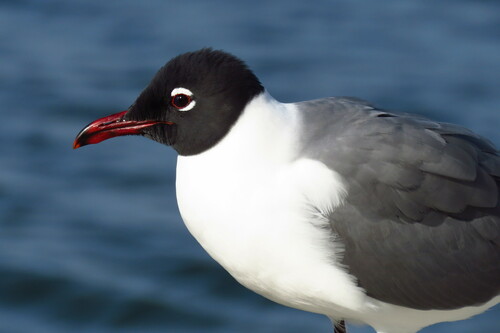
Laughing Gull
The Laughing Gull (*Leucophaeus atricilla*) is a medium-sized gull, readily identifiable by its distinctive, raucous call that resembles a high-pitched laugh. It plays a significant role in coastal ecosystems as both a scavenger and predator, helping to control populations of small animals and clean up organic debris. This species is a common sight along the coasts of North and South America, and has some cultural significance in coastal communities, often symbolizing the seaside environment and the freedom of the open ocean. It is a highly adaptable bird, thriving in both natural and human-altered landscapes.
36-41 cm
Length
98-110 cm
Wingspan
Least Concern
Conservation Status
Distribution
The Laughing Gull breeds along the Atlantic coast of North America, from Nova Scotia south to Florida, the Gulf Coast, the Caribbean, and northern South America. It winters along both coasts of Central America and South America, as far south as Peru on the Pacific coast and Brazil on the Atlantic. Non-breeding birds may wander further inland.
Lifespan
Up to 22 years in the wild, though the average lifespan is likely shorter.
Laughing Gull's Habitat
Habitat Types
Coastal beaches, Estuaries, Salt marshes, Bays, Lagoons, Inlets, Harbors, Dredge spoil islands
Climate Zones
Temperate, Subtropical, Tropical
Adaptations
Laughing Gulls are well-adapted to saline environments. They possess salt glands above their eyes that allow them to excrete excess salt, enabling them to drink seawater. Their webbed feet are excellent for swimming and maneuvering in water.
Variations
Two subspecies are generally recognized: *L. a. atricilla* (eastern North America) and *L. a. megalopterus* (Caribbean and Pacific coast of Central America). *L. a. megalopterus* is slightly larger and darker.
Appearance
Breeding Plumage
Breeding adults have a black head, white body, and dark gray back and wings. Non-breeding adults have a white head with dark smudging. Juveniles are mottled brown and gradually acquire adult plumage over three years.
Seasonal Feather Changes
The most significant seasonal variation is the change in head color between breeding (black) and non-breeding (white) plumages.
Sex Based Plumage Differences
Minimal; males and females have similar plumage.
Notable Features
Black head (in breeding plumage), White eye crescents, Red bill (in breeding plumage), Dark gray wings, White body, Long, pointed wings
Diet and Feeding
Primary Foods
Small fish, Crustaceans, Insects, Mollusks, Marine worms, Eggs (of other birds), Carrion, Refuse
Foraging Behavior
Laughing Gulls are opportunistic feeders, employing various foraging techniques. They may fly and dip to the water's surface to catch fish, walk along beaches picking up invertebrates, or scavenge for scraps. They are also known to steal food from other birds (kleptoparasitism).
Specializations
Their relatively long, slender bill is well-suited for probing in sand and mud for prey. Their strong flight allows them to cover large distances in search of food.
Seasonal Diet Variations
Diet varies depending on prey availability. During the breeding season, they may focus more on small fish and crustaceans, while in winter, they may rely more on scavenging and readily available food sources, such as refuse.
Behavior
Social Structure
Highly social, often found in large flocks, especially during the non-breeding season. They breed in colonies, which can range from a few pairs to thousands of birds.
Communication
Distinctive 'laughing' call, Variety of other vocalizations, including alarm calls and contact calls, Visual displays, such as head-tossing and bowing
Migration
Many populations are migratory, moving south for the winter. Northern populations undertake the longest migrations. The timing and extent of migration vary depending on location and food availability.
Territorial or Group Behaviors
During the breeding season, Laughing Gulls are highly territorial, defending their nesting sites from intruders. Outside of the breeding season, they are more gregarious and often form large feeding and roosting flocks.
Conservation
Threats
Habitat loss and degradation (due to coastal development and erosion), Human disturbance (at breeding colonies), Pollution (including oil spills and plastic ingestion), Climate change (sea level rise affecting nesting sites), Predation (by introduced predators like rats and cats on some islands)
Protection Programs
Protection of nesting colonies, Habitat restoration projects, Monitoring of populations, Public awareness campaigns
Local National Laws
Protected under the Migratory Bird Treaty Act in the United States.
Population Trend
Stable
Population Estimates
The global population is estimated to be around 1.2-2.8 million individuals.
Interesting Facts
Laughing Gulls are known for their kleptoparasitic behavior.
They frequently steal food from other birds, including pelicans and terns.
They can drink both fresh and salt water.
Specialized salt glands above their eyes allow them to excrete excess salt.
Laughing Gulls acquire their full adult plumage in their third year.
Young birds go through several stages of plumage development before reaching maturity.
They are highly adaptable to human presence.
They often congregate near fishing boats and landfills, taking advantage of readily available food sources.
Faqs about Laughing Gull
What is the lifespan of a Laughing Gull?
Laughing Gulls can live up to 22 years in the wild, although the average lifespan is likely shorter.
Where do Laughing Gulls nest?
Laughing Gulls nest on the ground, usually in colonies located on beaches, salt marshes, or islands.
What do Laughing Gulls eat?
Laughing Gulls are opportunistic feeders and eat a wide variety of food, including small fish, crustaceans, insects, mollusks, eggs, carrion, and refuse.
Why are they called Laughing Gulls?
They are named for their distinctive call, which sounds like a high-pitched laugh.
Are Laughing Gulls endangered?
No, Laughing Gulls are classified as Least Concern by the IUCN, meaning they are not currently considered to be at risk of extinction.
Copyright @ Nature Style Limited. All Rights Reserved.
 English
English